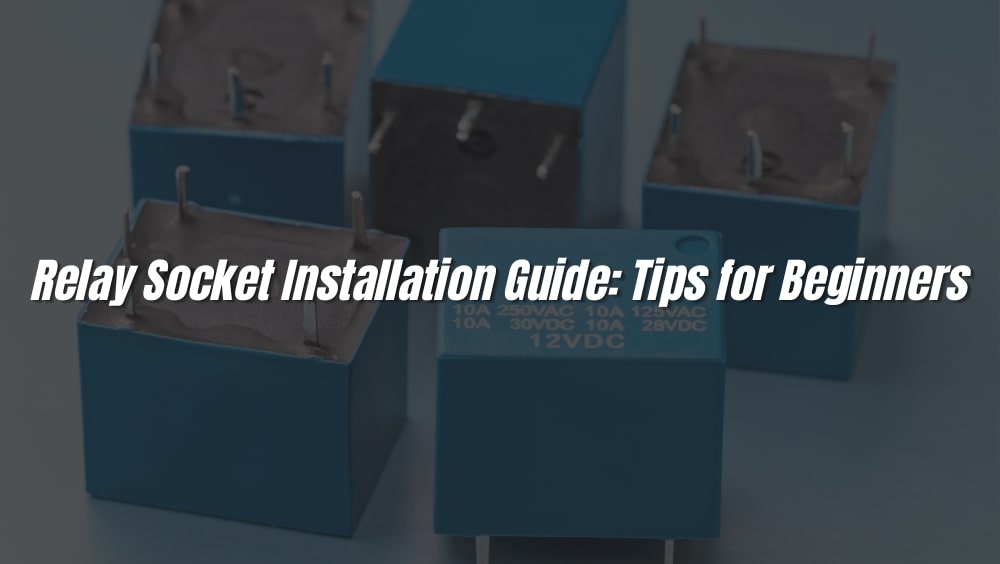Relay sockets are essential components in electrical control systems, and proper installation is crucial for ensuring device safety and stable operation. For beginners, understanding the basics and installation steps can help avoid common mistakes and improve both efficiency and safety.
Before you start, it’s recommended to familiarize yourself with relevant electrical standards and product specifications. This preparation will make the installation process smoother and more confident. With the right approach, installing relay sockets is not as complicated as it may seem.
This guide will walk you through the safe and precise installation of relay sockets step by step, helping you build a solid foundation and handle various installation scenarios with ease.
Understanding Relay Sockets
A relay socket is a simple yet vital component that securely holds a relay and connects it to the rest of your electrical circuit. It makes replacing a relay fast and safe without rewiring everything. There are various types, including plug-in, DIN rail mount, and PCB mount, each designed for different applications.
Tools and Materials Needed for Installation
Before you start, gather all the necessary tools:
- Screwdrivers (flathead and Phillips)
- Wire strippers and cutters
- Multimeter for testing
- Insulation tape and zip ties
- Safety gloves and goggles
Always use tools in good condition and check that you have the right gauge wires for your specific relay and socket.
Step-by-Step Installation Process
| Step | Description |
|---|---|
| 1. Preparation | Check specs and select correct socket. Inspect parts and turn off power. |
| 2. Mounting | Choose location, secure socket, ensure alignment and space. |
| 3. Wiring | Identify terminals, strip wires, connect firmly, double-check. |
| 4. Installing Relay | Insert relay until secure, confirm solid contact. |
| 5. Testing | Restore power, test with multimeter, check wiring if needed. |
1. Preparation
Before starting, always double-check the relay and socket specifications to ensure they match your circuit’s voltage and current needs. Select the right socket type—plug-in, DIN rail mount, or PCB mount—and inspect both the relay and socket for any damage. Never forget to turn off the power supply to avoid accidents.
2. Mounting the Relay Socket
Choose a safe, accessible spot inside a panel or enclosure to mount the relay socket securely. Use screws or clips to keep it firmly in place and properly aligned. Leave enough room for easy wiring, heat dissipation, and future maintenance.
3. Wiring the Relay Socket
Identify all terminal points: coil, common (COM), normally open (NO), and normally closed (NC). Strip wire ends to the right length and connect each wire to its designated terminal. Make sure connections are tight and correct, but don’t overtighten. Double-check the entire wiring before proceeding.
4. Installing the Relay
Once the socket is wired, carefully insert the relay straight into the socket until it clicks or locks into place. This ensures solid contact between relay pins and socket terminals. Lightly pull the relay to confirm it’s properly seated and secure.
5. Testing and Troubleshooting
Restore the power supply and use a multimeter to check that the relay is operating as expected. Verify the coil is energized and the contacts switch correctly. If it doesn’t work, recheck the wiring for loose or crossed connections and ensure the voltage matches the relay’s requirements.
Testing Your Installation for Proper Functionality
After completing the installation, it’s important to run a thorough functional test to ensure everything operates correctly. Begin by powering the system and activating the relay under normal operating load. Listen carefully for a distinct “click” sound, which indicates the coil is energizing properly. This audible confirmation is a key sign that the relay is engaging as expected.
Next, closely observe the connected device to verify that it switches on and off according to your control signals. If possible, test the relay’s operation under different load conditions to confirm that it performs reliably and consistently. Any irregularities or failure to switch should prompt a review of the wiring and installation to troubleshoot potential issues before regular use.
Common Mistakes to Avoid
One of the most frequent errors during relay installation is skipping the manual. Manufacturer specifications and wiring diagrams contain crucial information tailored to the specific model you’re working with. Ignoring these instructions can lead to incorrect wiring or improper setup, potentially damaging the relay or connected equipment.
Another common issue is loose connections. Even a slightly loose wire can cause intermittent faults, overheating, or electrical arcing, which not only affects performance but can also be a safety hazard. It’s essential to double-check that all connections are tight and secure.
Additionally, choosing the wrong socket for your relay is a mistake that can easily be avoided. Not all relays are compatible with every socket type — differences in dimensions, pin layouts, or ratings must be considered carefully to ensure proper fit and operation.
Finally, never neglect safety precautions. Working with live circuits without turning off the power puts you at risk of electric shock or injury. Always ensure the power is off before starting any wiring or installation work, and use appropriate protective gear when necessary.
Maintenance Tips for Relay Sockets
Regular Inspection:
Periodically check the relay sockets for any signs of corrosion, dirt accumulation, or overheating. Corrosion can increase electrical resistance, dirt can obstruct contacts, and overheating may indicate poor connections or overload.
Tighten Connections:
Ensure that all screws and terminals are firmly tightened. Vibrations and temperature changes can loosen connections over time, which can lead to intermittent faults, increased resistance, and heat generation.
Keep Dry and Clean:
Maintain a dry environment around the socket to prevent rust and electrical shorts caused by moisture. Remove dust and debris regularly using a soft brush or compressed air, avoiding harsh chemicals that could damage socket components.
Prompt Replacement:
Replace any sockets showing signs of wear, cracks, discoloration, or other damage immediately. Damaged sockets pose safety risks and can lead to relay malfunction or electrical hazards such as arcing or fire.
Troubleshooting Guide
No Power
First, verify that the supply voltage is present and within the specified range for your relay. Check all fuses and circuit breakers to ensure none are blown or tripped, as this can interrupt power flow to the socket.
Relay Doesn’t Switch:
If the relay fails to activate, inspect the coil wiring for correct connections and any visible damage. Testing the relay with a known working unit can help isolate whether the problem lies with the relay itself or the socket wiring.
Sporadic Operation:
Intermittent or unreliable switching often results from loose terminals or oxidized contacts. Carefully inspect all connection points, tighten any loose screws, and clean oxidation if present. Reseating the relay—removing it and reinstalling firmly—can also restore proper contact.
Use a Multimeter:
Employ a multimeter to measure continuity and verify electrical connections throughout the circuit. This tool helps detect open circuits, shorts, and ensures that all pathways are correctly connected, allowing you to pinpoint faults more effectively.
FAQs
Can I install a relay socket without an electrician?
Yes, but only if you’re confident with basic wiring and safety. For complex systems, consult a professional.
How do I know which socket fits my relay?
Match the relay pin configuration and voltage/current ratings to the socket specs.
What’s the lifespan of a relay socket?
With proper installation and maintenance, a quality socket can last many years.
Conclusion
With this guide, you have learned the key steps and precautions for installing relay sockets. Safety always comes first—carefully check all wiring and fastening points to ensure the equipment works correctly. Don’t forget to test the system after installation to confirm stable operation.
Regular maintenance is also important. Periodic inspections and cleaning can extend the lifespan of your devices and reduce the risk of faults. Good habits are essential for long-term reliability.
If you are looking for high-quality relay sockets, the CDGKZ brand is a trustworthy choice. We offer reliable, high-performance products that help you complete installations easily and use them with confidence. Feel free to reach out for consultation and purchasing!
Related Recommendations:
How to Select the Right Relay Socket
Relay Socket Types: What Socket Types Are Available?






